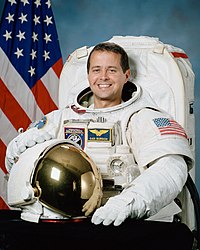Daniel W. Bursch
| Daniel Bursch | |
|---|---|

|
|
| Country: | United States |
| Organization: | NASA |
| selected on | Jan 17, 1990 ( 13th NASA Group ) |
| Calls: | 4 space flights |
| Start of the first space flight: |
September 12, 1993 |
| Landing of the last space flight: |
June 19, 2002 |
| Time in space: | 226d 22h 16min |
| EVA inserts: | 2 |
| EVA total duration: | 11h 48min |
| retired on | June 2005 |
| Space flights | |
Daniel Wheeler "Dan" Bursch (born July 25, 1957 in Bristol , Pennsylvania ) is a former American astronaut .
Bursch received a bachelor's degree in physics from the United States Naval Academy in 1979 and a master's degree in engineering from the Naval Postgraduate School in 1991 . From 1979 to 1989 he served in the US Navy , where he was trained as a pilot. His flying experience spans over 3,400 hours of flight time with more than 35 different aircraft.
Astronaut activity
After his selection by NASA in January 1990, he worked, among other things, in development for the Space Shuttle and the International Space Station and as CAPCOM at the Lyndon B. Johnson Space Center .
STS-51
On September 12, 1993, he took off with the Discovery as part of the STS-51 mission on its first flight into space. He suspended the Advanced Communications Technology Satellite (ACTS) and the Shuttle Pallet Satellite ( ORFEUS-SPAS ). The latter American and German scientific experiments had including an ultraviolet - spectrometer on board. In a seven-hour spacewalk his colleagues tested James H. Newman and Carl E. Walz tools and methods to repair the Hubble Space Telescope . After ORFEUS-SPAS had flown freely for six days and had moved approx. 65 km from the Discovery, Bursch finally caught it again with the help of the space shuttle's robot arm. After circumnavigating the earth 158 times, the Discovery was the first shuttle to land at the Kennedy Space Center that night .
STS-68
For the STS-68 mission , he flew into space on September 30, 1994 on the space shuttle Endeavor . It was the Space Radar Laboratory's second flight. The two main instruments on board were the SIR-C / X-SAR (Shuttle Imaging Radar-C / X-Band Synthetic Aperture Radar) and MAPS (Measurement of Air Pollution from Satellites). On October 11th, the space shuttle landed at Edwards Air Force Base in California .
STS-77
The STS-77 mission started with the space shuttle Endeavor on May 19, 1996 and was the fifth mission of the commercial Spacehab module. A dozen experiments from the fields of biology , electrical engineering and agriculture were carried out there. Furthermore, the SPARTAN platform was suspended, which in turn carried the so-called Inflatable Antenna Experiment (IAE). The $ 14 million IAE was an aluminum-coated plastic shell that was shaped into its actual shape - an antenna dish - using nitrogen gas. The ten-day operation was the first flight to be managed from takeoff to landing from the new Consolidated Control Center (CCC) in Houston.
ISS expedition 4
Bursch last started on December 5, 2001 as a flight engineer for the fourth long-term crew with the space shuttle Endeavor ( STS-108 ) to the International Space Station (ISS). Other members of the fourth ISS crew were Juri Onufrijenko and Carl E. Walz. On 25 January 2002 Bursch took along with Onufrienko a spacewalk, bringing to six deflector shields for the steering jets of Zvezda to -modules. Another amateur radio antenna and four scientific experiments were installed and a device for measuring material from the nozzles was replaced. This spacecraft lasted five hours and 59 minutes. The next spacecraft mission that Bursch undertook together with Walz on February 20, 2002 was only slightly shorter, at 5 hours and 49 minutes. The Quest airlock was tested and prepared for future exits. Another highlight of the ISS expedition 4 was the visit to the space shuttle Atlantis in April 2002. During this mission ( STS-110 ) the grid element S0 was brought to the ISS and installed. After a flight time of 195 days, 19 hours and 39 minutes, Bursch returned to Earth on June 19, 2002 aboard the space shuttle Endeavor with the STS-111 mission . With this, Bursch and Walz held the record for the longest single US space flight until 2007.
Private
Bursch and his wife Roni have four children.
See also
- List of spacemen
- List of space shuttle missions
- List of manned space flights
- List of space exits
- List of ISS expeditions
- List of manned missions to the International Space Station
Web links
- Burschs website (English)
- Short biography of Daniel W. Bursch at spacefacts.de
- NASA biography of Daniel W. Bursch (English; PDF)
- Biography of Daniel W. Bursch in the Encyclopedia Astronautica (English)
| personal data | |
|---|---|
| SURNAME | Bursch, Daniel W. |
| ALTERNATIVE NAMES | Bursch, Daniel Wheeler; Bursch, Dan (nickname) |
| BRIEF DESCRIPTION | American astronaut |
| DATE OF BIRTH | July 25, 1957 |
| PLACE OF BIRTH | Bristol , Pennsylvania |